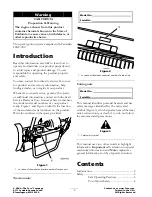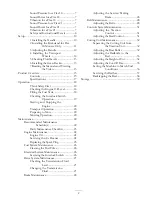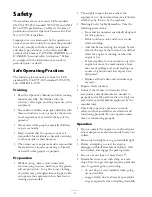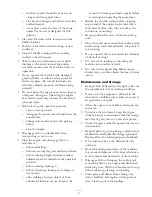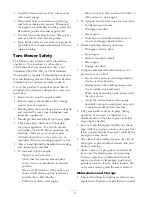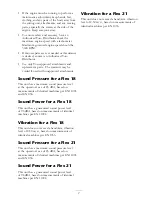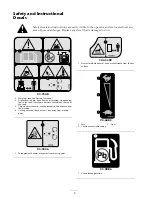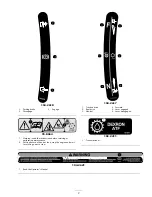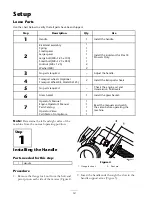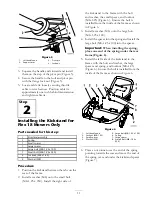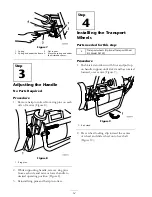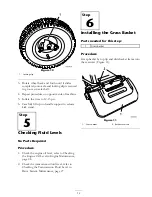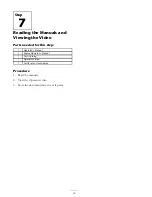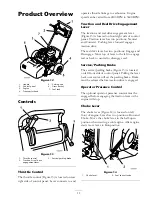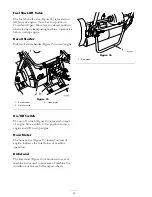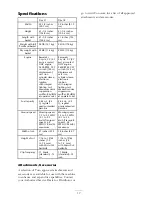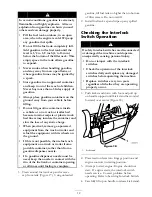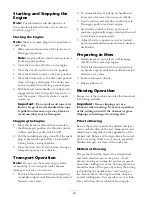
– machine speeds should be kept low on
slopes and during tight turns;
– stay alert for humps and hollows and other
hidden hazards;
– never mow across the face of the slope,
unless the mower is designed for this
purpose.
•
Stay alert for holes in the terrain and other
hidden hazards.
•
Watch out for traffic when crossing or near
roadways.
•
Stop the blades rotating before crossing
surfaces other than grass.
•
When using any attachments, never direct
discharge of material toward bystanders
nor allow anyone near the machine while in
operation.
•
Never operate the machine with damaged
guards, shields, or without safety protective
devices in place. Be sure all interlocks are
attached, adjusted properly, and functioning
properly.
•
Do not change the engine governor settings or
overspeed the engine. Operating the engine
at excessive speed may increase the hazard of
personal injury.
•
Before leaving the operator’s position:
– stop on level ground;
– disengage the power take-off and lower the
attachments;
– change into neutral and set the parking
brake;
– stop the engine.
•
Disengage drive to attachments when
transporting or not in use.
•
Stop the engine and disengage drive to
attachment
– before refuelling;
– before removing the grass catcher/catchers;
– before making height adjustment unless
adjustment can be made from the operator’s
position.
– before clearing blockages;
– before checking, cleaning or working on
the mower;
– after striking a foreign object or if an
abnormal vibration occurs. Inspect the
mower for damage and make repairs before
restarting and operating the equipment.
•
Reduce the throttle setting before stopping
engine and, if the engine is provided with a
fuel shut-off valve, turn the valve off at the
conclusion of mowing.
•
Keep hands and feet away from the cutting
unit.
•
Slow down and use caution when making turns
and crossing roads and sidewalks. Stop reels if
not mowing.
•
Do not operate the mower under the influence
of alcohol or drugs
•
Use care when loading or unloading the
machine into a trailer or truck
•
Use care when approaching blind corners,
shrubs, trees, or other objects that may obscure
vision.
Maintenance and Storage
•
Keep all nuts, bolts and screws tight to be sure
the equipment is in safe working condition.
•
Never store the equipment with fuel in the
tank inside a building where fumes may reach
an open flame or spark.
•
Allow the engine to cool before storing in any
enclosure.
•
To reduce the fire hazard, keep the engine,
silencer, battery compartment and fuel storage
area free of grass, leaves, or excessive grease.
•
Check the grass catcher frequently for wear or
deterioration.
•
Keep all parts in good working condition and
all hardware and hydraulic fittings tightened.
Replace all worn or damaged parts and decals.
•
If the fuel tank has to be drained, do this
outdoors.
•
Be careful during adjustment of the machine
to prevent entrapment of the fingers between
moving blades and fixed parts of the machine.
•
Disengage drives, disengage the cutting unit,
set parking brake, stop engine and disconnect
spark plug wire. Wait for all movement to stop
before adjusting, cleaning or repairing.
•
Clean grass and debris from cutting unit,
drives, mufflers, and engine to help prevent
fires. Clean up oil or fuel spillage.
5


